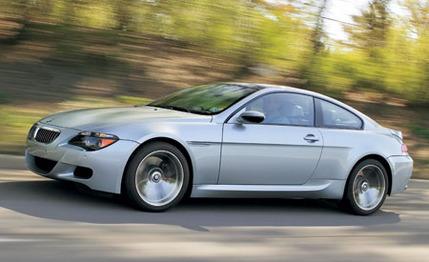 Road Test
Road Test
BMW's high-performance M group doesn't devote its energies to the company's big coupes very often — this is the second M6, and it's been 23 years since the first was introduced. The hiatus is a little puzzling. This is the kind of car that tends to seduce the slightly older guy who has wads of disposable cash earmarked for automotive self-indulgence — CEOs and CFOs, for example, presuming they're not under federal indictment.
The formula is simple: make plenty of power, plenty of panache, and seating for just the driver and the occasional special passenger. Yes, yes, the M6 has a rear seat, and with cooperation from those up front, adults can in fact arrange themselves back there. But like the parcel-shelf rear seat in a Porsche 911, it's best suited to stowing a case of Dom Pérignon and a couple pounds of beluga caviar for an emergency supply run to Sag Harbor.
Practicality isn't a part of the equation here. Neither is sharing. Aside from that occasional right-seat occupant one wishes to (a) impress, (b) terrify, (c) sleep with, or (d) all of the above, a car such as this is conceived for the gratification of its owner. And what could be more gratifying than leather-lined opulence hurled down the road by 500 horsepower? With suspension and braking equal to the propulsion?
Hardware: The subdermal M6 is structurally similar to, but not quite identical with, the M5 sedan. At 109.5 inches, the wheelbase is 4.2 inches shorter than the M5's, and there are also tiny track-dimension differences, although overall length is all but identical. Sheetmetal distinctions are obviously more profound. There are fewer doors, and the 54.0-inch roofline is 3.8 inches lower than the M5's.
Like the M5, the coupe's suspension involves struts up front, a multilink rear, anti-roll bars at both ends, and adjustable damping. It has the same brakes — immense vented and cross-drilled rotors — and the same tire spec.
Where the coupe holds the edge over its four-door counterpart is at the scales: At 3908 pounds, this M6 is 202 pounds lighter than the M5 we tested in our January issue ["Bahn Burners, Episode 39"]. A carbon-fiber roof panel contributes to this advantage, and also to a slightly lower center of gravity. But it's interesting to note that for all the whittling by the M engineers in Garching, Germany, the M6 is 48 pounds heavier than the 645Ci we tested two years ago ["High-End Sports Coupes," May 2004]. Mark it down to the M6's bigger wheels, bigger brakes, and bigger engine.
Ah, yes, the engine. Although its 4999cc displacement is only 58cc greater than that of the previous M V-8, and the cylinder-bank angle is identical at 90 degrees, similarity between the old V-8 and the new V-10 ends right there. The V-8 was a modestly oversquare design (a 94mm bore and an 89mm stroke) with a moderately high redline (7000 rpm) and better-than-moderate output: 368 pound-feet of torque at 3800 rpm, 394 horsepower at 6600 rpm. We thought it was pretty hot stuff when it appeared in 1999.
But the V-10 makes the V-8 seem a little tame. With its short-stroke design (92.0mm by 75.2), variable valve timing, individual throttles for each cylinder, lightweight valvetrain, and various tweaks distilled from BMW's F1 and other racing programs, the V-10 is, as we might say in Bavaria, a shcreamuh: 500 horsepower at 7750 rpm, 383 pound-feet of torque at 6100 rpm, 8250-rpm redline. It also emits sounds that can provoke mildly sociopathic behavior. This is true at any rpm north of idle, but more so as speed climbs, a sweet crescendo of temptation. Make that a well-nigh irresistible crescendo. No warning labels for this, by the way. You're on your own.
A cool footnote to the V-10's heroic output is that part of it is a sort of ready reserve, like a nitrous bottle waiting to add the magic of more oxygen to the combustion events. For profiling around town or routine freeway cruising, the V-10 maxes at a mere 400 horsepower. When the driver wants more, he taps into a 100-hp strategic reserve by pushing a console button that tells the ECU to open the throttles all the way. The button reads "Power," and it's not kidding. Every car should have one.